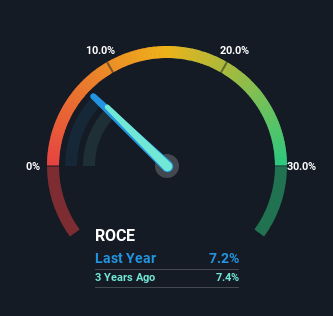There Are Reasons To Feel Uneasy About Parkland's (TSE:PKI) Returns On Capital
If you're looking for a multi-bagger, there's a few things to keep an eye out for. Ideally, a business will show two trends; firstly a growing return on capital employed (ROCE) and secondly, an increasing amount of capital employed. This shows us that it's a compounding machine, able to continually reinvest its earnings back into the business and generate higher returns. However, after briefly looking over the numbers, we don't think Parkland (TSE:PKI) has the makings of a multi-bagger going forward, but let's have a look at why that may be.
We've discovered 4 warning signs about Parkland. View them for free.Understanding Return On Capital Employed (ROCE)
For those that aren't sure what ROCE is, it measures the amount of pre-tax profits a company can generate from the capital employed in its business. Analysts use this formula to calculate it for Parkland:
Return on Capital Employed = Earnings Before Interest and Tax (EBIT) ÷ (Total Assets - Current Liabilities)
0.072 = CA$771m ÷ (CA$14b - CA$3.4b) (Based on the trailing twelve months to December 2024).
Thus, Parkland has an ROCE of 7.2%. In absolute terms, that's a low return and it also under-performs the Oil and Gas industry average of 9.2%.
See our latest analysis for Parkland

In the above chart we have measured Parkland's prior ROCE against its prior performance, but the future is arguably more important. If you'd like, you can check out the forecasts from the analysts covering Parkland for free.
How Are Returns Trending?
In terms of Parkland's historical ROCE movements, the trend isn't fantastic. Over the last five years, returns on capital have decreased to 7.2% from 10% five years ago. And considering revenue has dropped while employing more capital, we'd be cautious. If this were to continue, you might be looking at a company that is trying to reinvest for growth but is actually losing market share since sales haven't increased.
The Key Takeaway
In summary, we're somewhat concerned by Parkland's diminishing returns on increasing amounts of capital. Despite the concerning underlying trends, the stock has actually gained 31% over the last five years, so it might be that the investors are expecting the trends to reverse. Either way, we aren't huge fans of the current trends and so with that we think you might find better investments elsewhere.
Parkland does have some risks, we noticed 4 warning signs (and 1 which is potentially serious) we think you should know about.
While Parkland may not currently earn the highest returns, we've compiled a list of companies that currently earn more than 25% return on equity. Check out this free list here.
Have feedback on this article? Concerned about the content? Get in touch with us directly. Alternatively, email editorial-team (at) simplywallst.com.
This article by Simply Wall St is general in nature. We provide commentary based on historical data and analyst forecasts only using an unbiased methodology and our articles are not intended to be financial advice. It does not constitute a recommendation to buy or sell any stock, and does not take account of your objectives, or your financial situation. We aim to bring you long-term focused analysis driven by fundamental data. Note that our analysis may not factor in the latest price-sensitive company announcements or qualitative material. Simply Wall St has no position in any stocks mentioned.
 Wall Street Journal
Wall Street Journal